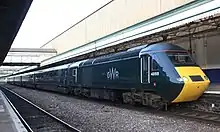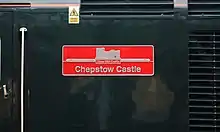British Rail Classes 253, 254 and 255
Class 253, Class 254 and Class 255 are TOPS classifications that have been applied to InterCity 125 high speed trains in Great Britain in the past. The classifications are not currently in official use, but the Class 255 designation was resurrected by Great Western Railway for their short-formed 2+4 sets in 2019.
| British Rail Classes 253 and 254 High Speed Train | |
|---|---|
 Class 253 at Dawlish Warren in the 1970s | |
| In service | 1976 – present |
| Manufacturer | British Rail Engineering Limited |
| Family name | High Speed Train |
| Replaced | Separate locomotives and carriages |
| Constructed | 1975 – 1982 |
| Number built | 58 sets (Class 253) 36 sets (Class 254) |
| Number in service | 54 sets |
| Number preserved | 4 power cars |
| Number scrapped | 3 sets |
| Formation | 2+7 cars (Class 253) 2+8 cars (Class 254) |
| Fleet numbers | 253001-253058 254001-254036 |
| Operator(s) | Western Region Eastern Region Scottish Region InterCity |
| Line(s) served | Great Western Main Line East Coast Main Line Cross Country Route Midland Main Line |
| Specifications | |
| Car body construction | Steel |
| Maximum speed | 125 mph (200 km/h) |
| Prime mover(s) | Paxman Valenta 12cyl 12RP200L |
| Power output | 2,250 bhp (1,680 kW) per power car |
History
Class 253 and 254
.jpg.webp)
When built, from 1976 onwards, the InterCity 125 rolling stock was classified in the diesel-electric multiple unit (DEMU) series; with semi-fixed formations of power cars and intermediate passenger-carrying trailer cars. They were all numbered in the 4xxxx carriage series. Numbers followed on from those allocated to the prototype Class 252; power cars being numbered from 43002 upwards. Class 253 were Western Region 2+7 (two power cars and seven coaches) sets operating out of London Paddington, Class 254 Eastern Region and Scottish Region 2+8 sets operating out of London King's Cross.[1][2]
Because power cars could be serviced independently of their allocated set number, the initial set numbering was abolished on the power cars once they started to be moved between sets – the power cars were then reclassified class 43 locomotives once divorced from the initial fixed formations and the trailers treated as coaching stock (albeit remaining dedicated to InterCity 125 formations. None of this resulted in power car or carriage renumbering.
Classes 253 and 254 are still referenced in the Network Rail Scottish sectional appendix.[3]
| Class | Operator | Number | Year Built | Cars per Set | Set Numbers. |
|---|---|---|---|---|---|
| Class 253 | BR Western Region | 27 | 1975-1977 | 9 | 253 001-253 027 |
| 13 | 1978-1979 | 253 028-253 040 | |||
| BR Cross Country | 18 | 1981-1982 | 253 041-253 058 | ||
| Class 254 | BR Eastern Region | 32 | 1977-1979 | 10 | 254 001-254 032 |
| BR Scottish Region | 4 | 1982 | 254 033-254 036 |
Class 255
| British Rail Class 255 Challenger | |
|---|---|
| In service | Never Introduced |
| Manufacturer | British Rail Engineering Limited |
| Family name | High Speed Train |
| Constructed | 1975 – 1982 2002 (planned refurbishment) |
| Number built | 14 sets (planned) |
| Formation | 2+5 cars |
| Operator(s) | Virgin CrossCountry |
| Specifications | |
| Car body construction | Steel |
| Maximum speed | 125 mph (200 km/h) |
| Prime mover(s) | Paxman Valenta 12 cyl 12RP200L |
| Power output | 2,250 bhp (1,680 kW) per power car |
In 2002, Class 255 was allocated for the reformation of some HST power cars and trailers into semi-fixed formation trains, to be known as Virgin Challengers, for use by Virgin CrossCountry after the introduction of its new Voyagers (classes 220 and 221). These formations would have had power cars sandwiching one Trailer First, a Trailer Buffet, two Trailer Seconds and a Trailer Guard Second, and were intended for use on planned services between Blackpool, Manchester and Birmingham, and Paddington to Birmingham via Swindon.[4] These plans were later abandoned with the Strategic Rail Authority deciding to transfer most of the stock to Midland Mainline for London St Pancras to Manchester Project Rio services.[5][6]
| Class | Operator | Number | Year Built | Cars per Set | Numbers |
|---|---|---|---|---|---|
| Class 255 | Virgin CrossCountry | 14 (planned) | 2002 (planned refurbishment) | 2+5 | 255001-255014 |
Present
Great Western Railway's short formed HST sets have been designated the Class 255 Castle classification, though this is not a TOPS classification as they are still InterCity 125 trains.[7] Following their use on intercity services with GWR until the Class 800 and Class 802 units took over, GWR announced they would be retaining eleven four-carriage sets for increasing capacity on local and regional services between Cardiff Central, Bristol Temple Meads, Taunton, Exeter St Davids, Plymouth and Penzance, with one set spare.[8][9] With twelve sets total, 48 Mark 3 coaches with sliding doors and 24 Class 43 powercars will be kept to form these sets, with the new addition of toilet retention tanks and a passenger information system.[10] The first set for GWR entered service in March 2019.
| Class | Operator | Number | Year Built | Cars per Set |
|---|---|---|---|---|
| Class 255 Castle | Great Western Railway | 12 | 2018-20 (refurbishment) | 4 |
Named powercars
With the sets being known as Castle sets, GWR announced that most powercars in the fleet would be receiving a nameplate based on a traditional castle from the south-west.[11][12] Other powercars which are not going to have castle nameplates will keep their current ones too.


| Number | Nameplate |
|---|---|
| 43004 | Caerphilly Castle |
| 43041 | St Catherine's Castle |
| 43042 | Tregenna Castle |
| 43092 | Cromwell's Castle |
| 43093 | Old Oak Common HST Depot 1976-2018 |
| 43094 | St Mawes Castle |
| 43097 | Castle Drogo |
| 43098 | Walton Castle |
| 43122 | Dunster Castle |
| 43153 | Chûn Castle |
| 43154 | Compton Castle |
| 43155 | Rougemont Castle |
| 43158 | Kingswear Castle |
| 43170 | Chepstow Castle |
| 43186 | Taunton Castle |
| 43187 | Y Cymru The Welshman |
| 43188 | Newport Castle
Y Cymru The Welshman / Geraint Thomas |
| 43189 | Launceston Castle |
| 43192 | Trematon Castle |
| 43194 | Okehampton Castle |
| 43198 | Driver Brian Cooper 15 June 1947 - 5 October 1999
Driver Stan Martin 25 June 1960 - 6 November 2004 |
Formation
The vehicle types used to form High Speed Trains are listed below:
| Number Range | Type | Notes |
|---|---|---|
| 400xx | Trailer Buffet (TRSB) | Renumbered 404xx in 1983; some converted to 402xx series |
| 403xx | Trailer Buffet (TRUB) | All converted to 407xx series (first class) |
| 405xx | Trailer Kitchen (TRUK) | All withdrawn and converted for other uses |
| 41xxx | Trailer First (TF) | Majority in service, some converted or scrapped |
| 42xxx | Trailer Second (TS) | Majority in service, some converted or scrapped |
| 43002-43198 | Driving Motor (Brake) (DM or DMB) | Majority in service, three scrapped after accidents, 43002 preserved |
| 44000-44101 | Trailer Guard Second (TGS) | Majority in service, some converted |
The 197 power cars produced are numbered 43002-43198. The two prototype power cars, were originally numbered 41001 and 41002, latterly becoming 43000 and 43001.
Accidents and incidents
- On 29 November 1979, 254028 was derailed at Northallerton, North Yorkshire.[13]
References
- "Class 253 High Speed Train". Railblue.co.uk. Archived from the original on 15 July 2011. Retrieved 15 February 2011.
- "Class 254 High Speed Train". Railblue.co.uk. Archived from the original on 15 July 2011. Retrieved 15 February 2011.
- "Sectional Appendix full PDF copies". Network Rail. Retrieved 19 March 2018.
- Virgin set to rebrand HSTs as Class 255 Challengers The Railway Magazine issue 1210 February 2002 page 4
- Virgin's HST Challenger project is put on ice Rail issue 453 22 January 2003 page 15
- Privatisation 1993 - 2005 125 Group
- Assisted Travel Team (2018). Making rail accessible: Helping older and disabled people (PDF) (Technical report). Great Western Railway. p. 69. 503058/02.
- Clinnick, Richard (21 May 2019). "Speculation increases over use of HSTs". Rail. Retrieved 19 August 2019.
- GWR to retain 11 HST sets for local services Today's Railways UK issue 181 January 2017 page 67
- Rossiter, Keith; Thomas, David (26 March 2018). "More seats and more services for Cornwall's trains". cornwalllive. Retrieved 10 February 2020.
- "HST Nameplate Display". Steam - Museum of the Great Western Railway. Archived from the original on 19 August 2019. Retrieved 19 August 2019.
- Hub, The Railway (3 September 2019). "GWR gives 'Castle' names to its HST power cars... and revives Class 255 designation". The Railway Hub. Retrieved 10 February 2020.
- Hoole, Ken (1983). Trains in Trouble: Vol. 4. Redruth: Atlantic Books. p. 36. ISBN 0-906899-07-9.
External links
| Wikimedia Commons has media related to High Speed Train. |